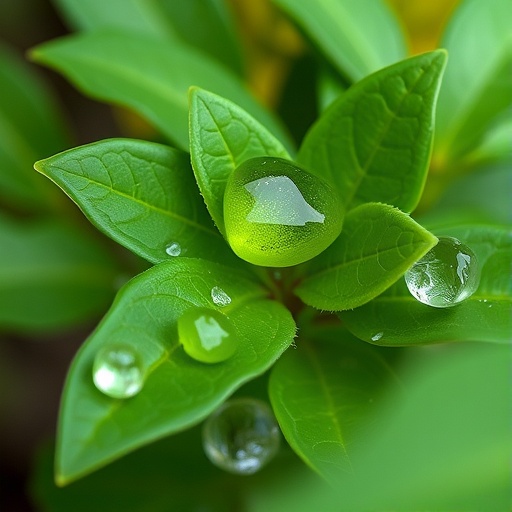Recent research has shed light on a troubling reality: plants can absorb microplastics from the atmosphere, leading to their accumulation within various species. This phenomenon, previously underestimated, indicates a more complex dynamic in our ecosystem’s food webs than previously thought. As concerns over plastic pollution escalate around the globe, the implications of this finding extend far beyond the immediate environment, encompassing agricultural practices, food safety, and human health.
Microplastics, tiny plastic particles measuring less than 5 millimeters, have infiltrated various ecosystems. Their widespread presence in terrestrial and aquatic environments poses significant risks not only to wildlife but also to human populations that depend on these ecosystems for food. While soil and aquatic microplastics have been studied extensively, the impact of atmospheric microplastics remains a relatively uncharted territory until recently. New evidence emerging from studies indicates that not only do these particles exist in the air, they can also permeate plant physiology and ultimately find their way into the food chain.
In a groundbreaking study, researchers utilized advanced mass spectrometry techniques to analyze leaves of different plant species, focusing specifically on the presence of polyethylene terephthalate (PET) and polystyrene (PS) microplastics. Results revealed that these polymers, commonly found in consumer products and packaging, were not only present but also quantifiable in the leaves of plants situated in polluted areas. In fact, concentrations were found to be alarmingly high, reaching up to 10,000 nanograms per gram of dry weight in leaves from high-pollution locales such as industrial areas and landfills.
Equally alarming is that even leafy vegetables grown in less contaminated environments can have detectable levels of PET and PS, ranging from 100 to 1,000 nanograms per gram. Such findings raise significant questions about the safety and health of the food produced in these environments. As the accumulation of these microplastics enters the food supply, human health could be at risk, given that the long-term effects of consuming microplastics remain largely unknown.
What makes these findings particularly fascinating is the method through which these particles are absorbed. Utilizing techniques such as hyperspectral imaging and atomic force microscopy–infrared spectroscopy, researchers were able to visually confirm the presence of nano-sized PET and PS particles within the leaves of maize plants. The study demonstrated that atmospheric microplastics can enter plant tissues through stomatal pathways, indicating a precise and efficient absorption method that plants employ under certain conditions.
Additionally, the research probes into the translocation mechanics of these absorbed particles. Once inside the plants, the microplastics can migrate towards vascular tissues using apoplastic pathways—a term referring to the route of water and solutes through the cell walls and intercellular spaces. This reveals a concerning dual functionality of microplastics: not only are they contaminants, but they can potentially affect plant physiology as they accumulate in critical tissues.
Beyond just maize, the findings suggest that nearly every plant species exposed to contaminated air could also be absorbing microplastics. The implications of such absorption extend to various agricultural practices, where the efficacy and safety of crops grown in polluted environments may be compromised. Farmers and agricultural policymakers must now consider the hidden dangers posed by atmospheric pollutants.
Moreover, the environmental impact extends to insects and other wildlife that may rely on these plants for food. As microplastics seep into the food chain, the potential for bioaccumulation becomes an urgent issue. If insects ingest these flying or adhering plastic particles on plants, the consequences ripple through the entire ecosystem, ultimately affecting larger animals and humans.
The long-term health effects remain largely unstudied; the ingestion of microplastics by humans through contaminated food could lead to adverse health outcomes. Research has indicated that microplastics could harbor harmful chemicals, increasing the risk of toxic effects when consumed. Public health initiatives may need to address this emerging issue, emphasizing the importance of understanding exposure risks associated with microplastics.
Given the significant findings of this research, further investigation into microplastics’ effects on plant absorption rates and implications for human consumption is imperative. The environmental sciences community must coordinate efforts to monitor atmospheric microplastic levels, alongside rigorous testing in crops cultivated near pollution sources.
While the research provides a clearer understanding of how plants interact with microplastics, much remains to be uncovered. Future studies could investigate the potential metabolic impacts on plant health or how various plant species exhibit different absorption capabilities. The interplay between microplastics and plant physiology is a burgeoning field that necessitates immediate attention.
As the alarm bell rings regarding plastic pollution, it is crucial that society acknowledges the interconnection between pollution and agriculture. This study serves as a wake-up call for consumers, policymakers, and researchers alike to take steps towards reducing plastic pollution, thereby safeguarding environmental and public health.
As research continues to evolve, the pressing question becomes: how can we mitigate our reliance on plastics to prevent such pervasive environmental issues? Ensuring a sustainable future hinges on our ability to address the challenge posed by microplastics head-on, striving towards a cleaner planet for generations to come.
Subject of Research: Atmospheric Microplastics Absorption by Plants
Article Title: Leaf absorption contributes to accumulation of microplastics in plants.
Article References:
Li, Y., Zhang, J., Xu, L. et al. Leaf absorption contributes to accumulation of microplastics in plants. Nature (2025). https://doi.org/10.1038/s41586-025-08831-4
Image Credits: AI Generated
DOI: 10.1038/s41586-025-08831-4
Keywords: Microplastics, Environmental Pollution, Plants, Food Safety, Human Health, Absorption, Ecosystems.




